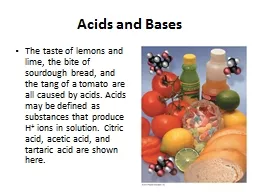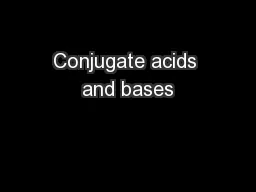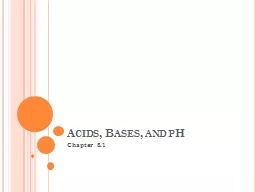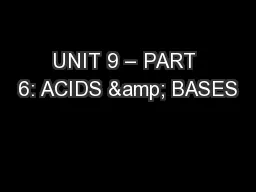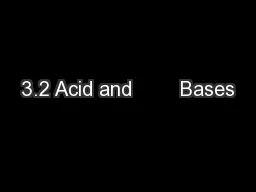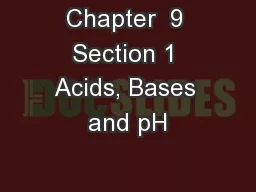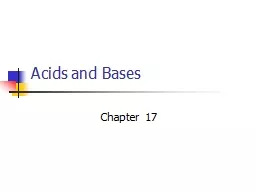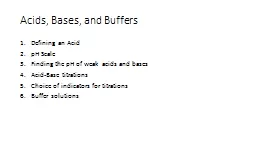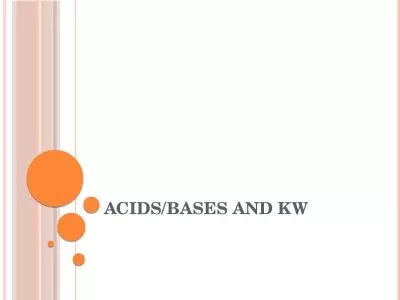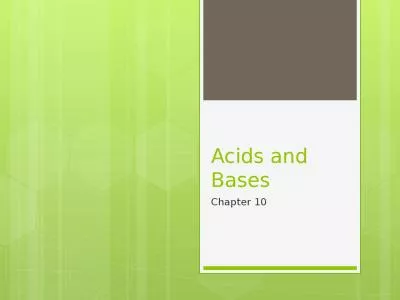PPT-3 Acids, Bases, and Buffers
Author : briana-ranney | Published Date : 2016-06-06
31 Defining an Acid 32 pH Scale 33 Finding the pH of weak acids and bases 34 AcidBase titrations 35 Choice of indicators for titrations 36 Buffer solutions 31 Defining
Presentation Embed Code
Download Presentation
Download Presentation The PPT/PDF document "3 Acids, Bases, and Buffers" is the property of its rightful owner. Permission is granted to download and print the materials on this website for personal, non-commercial use only, and to display it on your personal computer provided you do not modify the materials and that you retain all copyright notices contained in the materials. By downloading content from our website, you accept the terms of this agreement.
3 Acids, Bases, and Buffers: Transcript
31 Defining an Acid 32 pH Scale 33 Finding the pH of weak acids and bases 34 AcidBase titrations 35 Choice of indicators for titrations 36 Buffer solutions 31 Defining an acid Learning Objectives. Acids turn blue litmus to red 2 Acids turn methyl orange to red Bases effect indicators 1 Bases turn red litmus to blue 2 Bases turn methy l orange to yellow 3 Bases turn phenolphthalein to purple Acids neutralize bases producing a salt and water Ba &. Salts and Buffers. Chapter 19.3 and 19.5. Notes #21. Part 1: Strengths of Acids and Bases. How is there is a difference?. Citrus fruits contain citric acid that we can eat.. Industrial companies use sulfuric acid that can cause severe burns to the skin.. . The taste of lemons and lime, the bite of sourdough bread, and the tang of a tomato are all caused by acids. Acids may be defined as substances that produce H. +. ions in solution. Citric acid, acetic acid, and tartaric acid are shown here.. Topic 8.4. A. cids. w. hen a . STRONG. acid dissolves- all, or nearly all, of the acid molecules dissociate to produce H. +. . or H. 3. O. +. ions (reaction goes to “completion”). have a . very. Different definitions of acids and bases. Acids are proton donors (. Brønsted. Lowry definition). they generate H. 3. O. +. in water (Arrhenius definition). Bases are proton acceptors. they generate OH. Chapter 8.1. Objectives. Describe the ionization of strong acids in water and the dissociation of strong bases in water.. Distinguish between solutions of weak acids or bases and solutions of strong acids or bases.. MEASUREMENT. REACTIONS. The sour and spicy tastes are properties of acidic substances. The bitter taste is a . property of basic . substances. ACIDS & BASES. INTRODUCTION. Your own body produces acids and strong bases. . Acids and their properties. An acid is any compound that increases the number of . hydronium . ions. . Hydronium forms when and H separates from an acid and bonds with water = H. 3. O. . Acids have a . Explain the chemical composition of acids and bases, and explain the change of pH in neutralization reactions.. D12. I can differentiate between acids and bases.. Learning Target. When dissolved in water, they ionize (form ions). A special solution. Acids and bases are ALWAYS in a water solution.. Your body has water in it so they are always dangerous to living things.. Bases are just as dangerous as acids.. In low . concentrations. Defining an Acid. pH Scale. Finding the pH of weak acids and bases. Acid-Base titrations. Choice of indicators for titrations. Buffer solutions. Defining . an acid. Learning Objectives:. Describe a . Dr. Ron . Rusay. Fall . 2012. Chapter. 3. Structure . and . Bonding. Acids and Bases. Models of Acids and Bases. Arrhenius. : Acids produce H. . & bases produce OH. . ion in aqueous solutions .. Taken from State University of West Georgia Chemistry Dept.. Acid and Base Strengths. Taken from State University of West Georgia Chemistry Dept.. Hydronium Ions. Hydronium Ions. H. 5. O. 2. +. Dissociation of Water. Objectives. Relate the process of ionization to the formation of acids and bases. Explain qualities of acids and bases . Compare the acidity of substances, using the pH scale and pH indicators . Use molarity and titration to determine the concentration of an acid .
Download Document
Here is the link to download the presentation.
"3 Acids, Bases, and Buffers"The content belongs to its owner. You may download and print it for personal use, without modification, and keep all copyright notices. By downloading, you agree to these terms.
Related Documents



